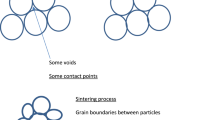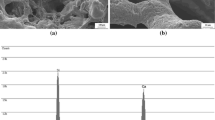Abstract
Tissue engineering scaffolds are implants that actively support tissue growth whilst providing mechanical support. For optimum functionality, they are designed to slowly dissolve in vivo so that no foreign material remains permanently implanted inside the body. The current study uses a simple degradation model that estimates the change of scaffold geometry due to surface erosion. This model is applied on scaffolds that have been manufactured using the foam replication method. In order to capture their complex geometry, micro-computed tomography scans of samples are obtained. Their change in geometry and degradation of mechanical properties is evaluated using computational analysis. The present investigation found that the mechanical properties such as the quasi-elastic gradient, 0.2 % offset yield stress and the plateau stress are decreased systematically over a 10-week period of immersion time. Deformation analysis on the titania foam scaffold is performed by means of the deformed model obtained from finite element calculations.









Similar content being viewed by others
References
Hench LL, Polak JM (2002) Third-generation biomedical materials. Science 295(5557):1014–1017
Eqtesadi S, Motealleh A, Miranda P, Pajares A, Lemos A, Ferreira JMF (2014) Robocasting of 45S5 bioactive glass scaffolds for bone tissue engineering. J Eur Ceram Soc 34(1):107–118
Ang TH, Sultana FSA, Hutmacher DW, Wong YS, Fuh JYH, Mo XM, Loh HT, Burdet E, Teoh S-H (2002) Fabrication of 3D chitosan–hydroxyapatite scaffolds using a robotic dispensing system. Mater Sci Eng C 20(1):35–42
Pfister A, Landers R, Laib A, Hübner U, Schmelzeisen R, Mülhaupt R (2004) Biofunctional rapid prototyping for tissue-engineering applications: 3D bioplotting versus 3D printing. J Polym Sci A 42(3):624–638
Midha S, Kim TB, van den Bergh W, Lee PD, Jones JR, Mitchell CA (2013) Preconditioned 70S30C bioactive glass foams promote osteogenesis in vivo. Acta Biomater 9(11):9169–9182
Chen QZ, Boccaccini AR (2006) Poly (D, L-lactic acid) coated 45S5 Bioglass®-based scaffolds: processing and characterization. J Biomed Mater Res A 77(3):445–457
Fu Q, Rahaman MN, Bal BS, Brown RF, Day DE (2008) Mechanical and in vitro performance of 13–93 bioactive glass scaffolds prepared by a polymer foam replication technique. Acta Biomater 4(6):1854–1864
Hutmacher DW, Sittinger M, Risbud MV (2004) Scaffold-based tissue engineering: rationale for computer-aided design and solid free-form fabrication systems. Trends Biotechnol 22(7):354–362
Yeong W-Y, Chua C-K, Leong K-F, Chandrasekaran M (2004) Rapid prototyping in tissue engineering: challenges and potential. Trends Biotechnol 22(12):643–652
Fu Q, Saiz E, Tomsia AP (2011) Bioinspired strong and highly porous glass scaffolds. Adv Funct Mater 21(6):1058–1063
Menon A (2009) Sintering Additives for Nanocrystalline Titania and Processing of Porous Bone Tissue Engineering Scaffolds. University of Central Florida Orlando, Florida
Uchida M, Kim H-M, Kokubo T, Fujibayashi S, Nakamura T (2003) Structural dependence of apatite formation on titania gels in a simulated body fluid. J Biomed Mater Res A 64A(1):164–170
Fu Q, Saiz E, Rahaman MN, Tomsia AP (2011) Bioactive glass scaffolds for bone tissue engineering: state of the art and future perspectives. Mater Sci Eng C 31(7):1245–1256
Jones JR, Ehrenfried LM, Hench LL (2006) Optimising bioactive glass scaffolds for bone tissue engineering. Biomaterials 27(7):964–973
Karl S, Somers AV (1963) Method of making porous ceramic articles. Google Patents, 1963
Chen QZ, Thompson ID, Boccaccini AR (2006) 45S5 Bioglass®-derived glass–ceramic scaffolds for bone tissue engineering. Biomaterials 27(11):2414–2425
Fu Q, Rahaman MN, Bal BS, Bonewald LF, Kuroki K, Brown RF (2010) Silicate, borosilicate, and borate bioactive glass scaffolds with controllable degradation rate for bone tissue engineering applications. II. In vitro and in vivo biological evaluation. J Biomed Mater Res A 95(1):172–179
Fu H, Fu Q, Zhou N, Huang W, Rahaman MN, Wang D, Liu X (2009) In vitro evaluation of borate-based bioactive glass scaffolds prepared by a polymer foam replication method. Mater Sci Eng C 29(7):2275–2281
Meng D, Rath SN, Mordan N, Salih V, Kneser U, Boccaccini AR (2011) In vitro evaluation of 45S5 Bioglass®-derived glass-ceramic scaffolds coated with carbon nanotubes. J Biomed Mater Res A 99(3):435–444
Fiedler T, Fisher M, Roether JA, Belova IV, Samtleben T, Bernthaler T, Murch GE, Boccaccini AR (2014) Strengthening mechanism of PDLLA coated titania foam. Mech Mater 69(1):35–40
Torio-Padron N, Paul D, von Elverfeldt D, Stark GB, Huotari AM (2011) Resorption rate assessment of adipose tissue-engineered constructs by intravital magnetic resonance imaging. J Plast Reconstr Aesthetic Surg 64(1):117–122
Kłodowski K, Kamiński J, Nowicka K, Tarasiuk J, Wroński S, Świętek M, Błażewicz M, Figiel H, Turek K, Szponder T (2014) Micro-imaging of implanted scaffolds using combined MRI and micro-CT. Comput Med Imaging Graph 38(6):458–468
Han X, Pan J (2009) A model for simultaneous crystallisation and biodegradation of biodegradable polymers. Biomaterials 30(3):423–430
Wang Y, Pan J, Han X, Sinka C, Ding L (2008) A phenomenological model for the degradation of biodegradable polymers. Biomaterials 29(23):3393–3401
Adachi T, Osako Y, Tanaka M, Hojo M, Hollister SJ (2006) Framework for optimal design of porous scaffold microstructure by computational simulation of bone regeneration. Biomaterials 27(21):3964–3972
Sanz-Herrera JA, Boccaccini AR (2011) Modelling bioactivity and degradation of bioactive glass based tissue engineering scaffolds. Int J Solids Struct 48(2):257–268
Winkelstein BA (2012) Orthopaedic biomechanics. CRC Press, Boca Raton
Göpferich A (1996) Mechanisms of polymer degradation and erosion. Biomaterials 17(2):103–114
Attawia MA, Herbert KM, Uhrich KE, Langer R, Laurencin CT (1999) Proliferation, morphology, and protein expression by osteoblasts cultured on poly (anhydride-co-imides). J Biomed Mater Res 48(3):322–327
Middleton JC, Tipton AJ (2000) Synthetic biodegradable polymers as orthopedic devices. Biomaterials 21(23):2335–2346
Hutmacher DW (2000) Scaffolds in tissue engineering bone and cartilage. Biomaterials 21(24):2529–2543
Wu L, Ding J (2004) In vitro degradation of three-dimensional porous poly(D, L-lactide-co-glycolide) scaffolds for tissue engineering. Biomaterials 25(27):5821–5830
Caty O, Maire E, Youssef S, Bouchet R (2008) Modeling the properties of closed-cell cellular materials from tomography images using finite shell elements. Acta Mater 56(19):5524–5534
Schneider CA, Rasband WS, Eliceiri KW (2012) NIH Image to ImageJ: 25 years of image analysis. Nat Meth 9(7):671–675
Kotov NA, Meldrum FC, Fendler JH (1994) Monoparticulate layers of titanium dioxide nanocrystallites with controllable interparticle distances. J Phys Chem 98(36):8827–8830
Veyhl C, Belova IV, Murch GE, Öchsner A, Fiedler T (2010) On the mesh dependence of non-linear mechanical finite element analysis. Finite Elem Anal Des 46(5):371–378
Tekkaya AE (2000) Relationship between Vickers Hardness and Yield Stress for Cold Formed Materials. Steel Res, 71(1)
Tabor D (1951) The hardness of metals, vol 10. Clarendon, Oxford
Li Z, Qu Y, Zhang X, Yang B (2009) Bioactive nano-titania ceramics with biomechanical compatibility prepared by doping with piezoelectric BaTiO3. Acta Biomater 5(6):2189–2195
Kalita SJ, Qiu S, Verma S (2008) A quantitative study of the calcination and sintering of nanocrystalline titanium dioxide and its flexural strength properties. Mater Chem Phys 109(2–3):392–398
I. Standard, ISO 13314:2011(E) (2011) Mechanical testing of metals—ductility testing—compression test for porous and cellular metals. Ref Number ISO 13314(13314):1–7
San Marchi C, Mortensen A (2001) Deformation of open-cell aluminum foam. Acta Mater 49(19):3959–3969
Conde Y, Despois J, Goodall R, Marmottant A, Salvo L, San Marchi C, Mortensen A (2006) Replication processing of highly porous materials. Adv Eng Mater 8(9):795–803
Rezwan K, Chen QZ, Blaker JJ, Boccaccini AR (2006) Biodegradable and bioactive porous polymer/inorganic composite scaffolds for bone tissue engineering. Biomaterials 27(18):3413–3431
Torres FG, Nazhat SN, Sheikh SH, Fadzullah SSM, Maquet V, Boccaccini AR (2007) Mechanical properties and bioactivity of porous PLGA/TiO2 nanoparticle-filled composites for tissue engineering scaffolds. Compos Sci Technol 67(6):1139–1147
Baker SC, Rohman G, Southgate J, Cameron NR (2009) The relationship between the mechanical properties and cell behaviour on PLGA and PCL scaffolds for bladder tissue engineering. Biomaterials 30(7):1321–1328
Badiche X, Forest S, Guibert T, Bienvenu Y, Bartout J-D, Ienny P, et al (2000) Mechanical properties and non-homogeneous deformation of open-cell nickel foams: application of the mechanics of cellular solids and of porous materials. Mater Sci Eng A 289:276–288
Niebur GL, Feldstein MJ, Yuen JC, Chen TJ, Keaveny TM (2000) High-resolution finite element models with tissue strength asymmetry accurately predict failure of trabecular bone. J Biomech 33:1575–1583
Zhou J, Shrotriya P, Soboyejo WO (2004) Mechanisms and mechanics of compressive deformation in open-cell Al foams. Mech Mater 36:781–797
Acknowledgements
This research was supported by the Australian Research Council through its Discovery Project DP130101377 “Structural design of third generation biomaterials”.
Author information
Authors and Affiliations
Corresponding author
Rights and permissions
About this article
Cite this article
Sulong, M.A., Belova, I.V., Boccaccini, A.R. et al. A model of the mechanical degradation of foam replicated scaffolds. J Mater Sci 51, 3824–3835 (2016). https://doi.org/10.1007/s10853-015-9701-x
Received:
Accepted:
Published:
Issue Date:
DOI: https://doi.org/10.1007/s10853-015-9701-x




